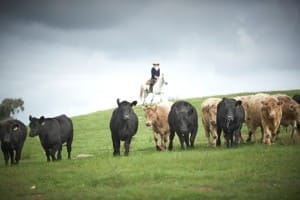 Beef producers are starting to tap into the recently launched Meat Standards Australia Index to track how changes to their production systems impact the eating quality of their cattle.
Beef producers are starting to tap into the recently launched Meat Standards Australia Index to track how changes to their production systems impact the eating quality of their cattle.
The Index was created to help producers understand the direct impact of decisions relating to genetic traits, breed composition, HGP use and other animal management decisions on eating quality, so they can more consistently meet market specifications.
MSA manager Richard Lower says the index represents an ‘enhancement’ rather than a change of direction for MSA, with MSA standards for livestock and grading unchanged.
MSA currently predicts an eating quality score for 39 major cuts in the carcase, using measurements collected by qualified MSA graders.
The MSA Index is a weighted average of these scores, using the most common cook method for each cut. It only takes into consideration the factors controlled by a producer, making it a standard national calculation regardless of processor or location.
Prior to the index, producers had to keep track of all the variable factors that impact on eating quality, such as marbling, hump height, ossification, HGP use, sex and hot standard carcase weight.
Now all those variables are all rolled into a single numerical figure – the MSA Index.
Producers are not required to do anything different on-farm to prepare cattle and consign them for MSA. The only difference is they will now receive an MSA Index score for each carcase that meets the minimum requirements for MSA grading.
Index score
The Index score is a number ranging between 30 and 80, expressed to two decimal places (ie 54.62). The higher the score, the greater the potential eating quality of the carcase.
- The factors with the most influence on the index are:
- Tropical breed content/hump height
- MSA marbling score
- Ossification (maturity) score
- HGP status
- Milk-fed vealer category
- Whether the cattle were delivered direct to processors or through the saleyards
Producers can access their MSA Index value, as well as a breakdown of the individual factors affecting these values, through the newly-developed MSA feedback system, myMSA.
The pilot myMSA website was launched in November 2013 and is undergoing refinements, based on producer feedback, so it is as user-friendly as possible.
The updated version of myMSA is expected to be released next month.
“Producers can use the index to target those factors that impact the eating quality of their individual herd, such as marbling or ossification,” MSA manager Richard Lower said.
“Processors may also use the index to indicate to producers the eating quality parameters expected for their brands, by nominating a preferred MSA Index range.”
Useful tool
Producers looking to increase eating quality can also use the new MSA Index calculator to predict the potential impact of production changes.
“For example, a producer might be receiving index results consistently below the level required by their particular processor,” Mr Lower said. “They can enter the carcase measurements from their feedback sheets straight into the calculator, and modify the measurements to reflect some ‘what if’ scenarios (such as increased marbling or carcase weight) to see what impact these production changes would have on the index value.”
The myMSA site also contains historical data for all MSA-graded cattle since 2010, with MSA Index values calculated for these animals.
This allowed producers to benchmark their own index data for the last four years, Mr Lower said.
“If a processor has asked for a certain index range in their company specification it will give the producers confidence to know what values their animals have been generating historically.”
“If improvements are required, then they can use tools like the MSA Index calculator to assist them.”
Wingham uses Indexes to advantage
 Producers selling MSA-eligible stock to Wingham Beef Exports in NSW are now receiving MSA Index results on their carcase feedback sheets. NH Foods’ (formerly Nippon Meat Packers) Wingham plant has been supplying the MSA Index results since February.
Producers selling MSA-eligible stock to Wingham Beef Exports in NSW are now receiving MSA Index results on their carcase feedback sheets. NH Foods’ (formerly Nippon Meat Packers) Wingham plant has been supplying the MSA Index results since February.
Livestock buyer Stephen Moy said the index was being used as the basis for pricing, replacing the former boning groups-based pricing system, for MSA-graded carcases.
Wingham has three MSA-graded categories:
- an antibiotic-free program
- the Wingham Blue brand, which is a 0–6 tooth product, both non-HGP and HGP treated, and
- the Manning Valley Naturally brand, which is HGP-free, 0-2 tooth and grassfed.
“Anything with an MSA Index of 50-plus will find a home on our MSA grid,” Mr Moy said.
He said Wingham Beef Exports had been spreading the word about the new MSA Index via a series of roadshows, run in conjunction with MLA’s livestock supply coordinator, Terry Farrell. Workshops have been held at Wingham, Gloucester, Willow Tree, Armidale, Dorrigo and Singleton.
“They’ve been well supported and there has been a pretty smooth acceptance of the new system, particularly among the bigger producers,” Mr Moy said.
Producer experience
Walcha, NSW, producers Rob and Maria Ireland sell 99pc of their cattle to Wingham Beef Exports. The couple run 650 breeders on their property, Bundagra, and finish cattle on two other properties.
While the majority of their steers go into the EU market, their 18-month-old cull heifers are targeted at the MSA-backed Manning Valley… Naturally brand.
“We’ve been MSA-accredited for a long time, but we only started selling MSA-cattle when Wingham launched their Manning Valley… Naturally brand a couple of years ago,” Mrs Ireland said.
“Now we’re receiving the MSA Index results on our feedback sheets and I think it’s a pretty good idea – it gives us a benchmark and an idea of how we’re going.
“Wingham requires an MSA Index score of at least 54.5 for the Manning Valley…Naturally carcases and our cattle have all gone better than that so far – they’ve averaged about 58 or 59. Our most recent consignment of 54 heifers ranged from 56 to 62.”
Mrs Ireland said she hadn’t yet tried out the MSA Index calculator, but could see its potential in helping producers who weren’t hitting their targeted grid, or wanted to target a new market.
“I think for those considering targeting a different market, the calculator could be quite useful, but we’re in the right grid for the cattle we want to sell,” she said.
Source: MLA

